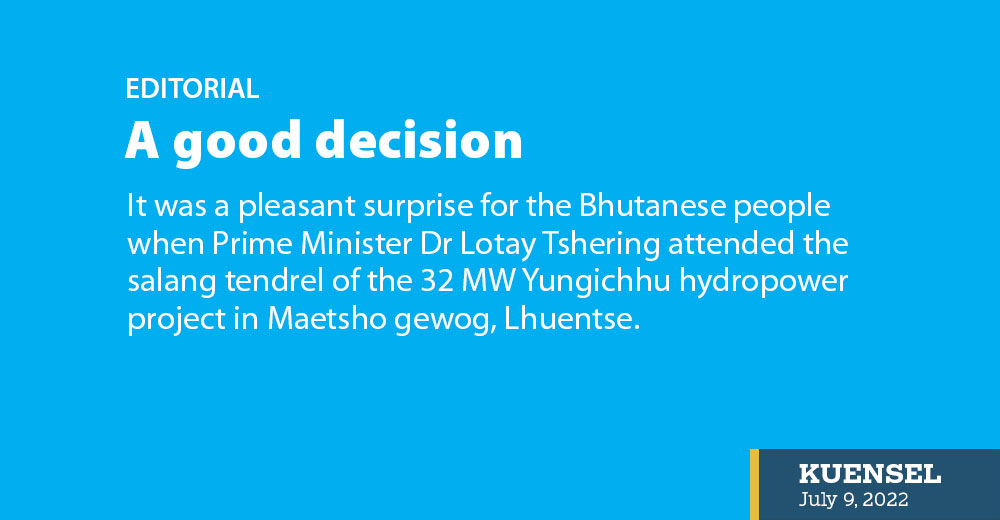It was a pleasant surprise for the Bhutanese people when Prime Minister Dr Lotay Tshering attended the salang tendrel of the 32 MW Yungichhu hydropower project in Maetsho gewog, Lhuentse.
Not many have heard of the small project in remote Lhuentse. Hydropower in the country, for us, conjures up the images of mega-projects along the Punatsangchhu river. We have two massive projects and it is known, unfortunately, for delays, cost escalations, irregularities and many other problems. The future of a third project is uncertain.
The Royal Government has embarked on an important project – to construct small hydropower projects in the country that will be built and operated by the Bhutanese people. Yungichhu is the first. It will be followed by more projects in Pemagatshel, Zhemgang, and Haa.
This is the beginning.
In the second phase, there are plans to build five more projects with a total installed capacity of 261MW. The projects will be in Samdrupjongkhar, Trashigang, Samtse, and Thimphu with detailed project reports and feasibility studies already completed.
The decision to go small is welcome. We have invested, heavily, in mega projects not knowing the surprises – geological or policy decisions. When a mega project is delayed there is not much we could do. Small is beautiful, so we say. In this case, small is achievable. There is a huge potential to generate about 33,000MW of electricity from hydropower. We have harnessed only about 7 percent.
The ambitious plan to harness more by investing in mega projects is what we call biting more than what we can chew. There are several factors hindering our projects. After years of heavy investments in mega projects, what is certain is the ballooning debt caused by delays. That our hydropower debts are self-liquidating is becoming more questionable. Delays in completing mean opportunity lost.
We are known for our smallness and the beauty of smallness. This should apply to the main export commodity- clean energy or hydroelectricity. Going small is not a failure. In fact, sticking to smaller projects could realize our target of energy sufficiency.
Building small projects within our capacity has other advantages. It is an opportune time for our engineers and contractors to put into practice what they have learnt over the years. The biggest advantage is that investment in hydropower, our potential, should create employment. Economic growth without job creation is false growth. This was the trend in the past when mega projects were constructed by big companies that employed their own employees.
Building smaller and more realistic projects involving our own contractors, engineers, workers and the community will be more beneficial than mega-projects constructed by foreigners.
As we venture into constructing small hydropower projects, what we need is a skilled workforce. From building retaining walls to constructing tunnels, Bhutanese should be trained. As we move from one small project to another, we should have more skilled people to take up all aspects of building a hydropower project. We could export this expertise.
We are starting the first project from Lhuentse, the birthplace of our Wangchuck dynasty. It is a good tendrel.


